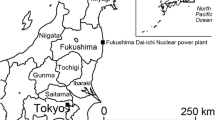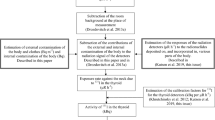Abstract
On April 26th 1986, an accidental explosion occurred at Chernobyl nuclear power station #4, located in the Ukraine, in the former Soviet Union. From May 1991, in order to prevent internal exposure to cesium-137 (137Cs) in the inhabitants of the Chechersk district of the Gomel region in the Republic of Belarus, which was an area highly contaminated by the Chernobyl accident, the author continuously measured internal137Cs accumulations within inhabitants of the district with a whole-body counter, and the levels of137Cs in milk, beef, pork, mushrooms, potatoes and flour with a GM-semiconductor detector.
Then the author analyzed the relationships between the inhabitants’ daily habits and their measured cesium levels. The author measured137Cs accumulation within 528 inhabitants and in agricultural produce in the Chechersk disrict.
There was no correlation between the internal137Cs levels within inhabitants and the surface contamination by137Cs within the residential area. However, a comparison of internal exposure levels by age and sex revealed a significant variation between adult males and both male and female children, and between adult males and females (p < 0.001).
Food supplied in school was the cause of lower levels in children because it was strictly controlled by the local health authority. The difference between adult males and adult females was thought to be due to the difference in the length of working time in the fields, or in the amount of food from pastures, lakes and forests.
Some of the measurement values of agricultural produce with the GM-semiconduc-tor detector exceeded the provisional standards of the Ministry of Health of the Republic of Belarus, where milk, beef, pork and mushrooms had been measured while potatoes and flour had not.
Results for milk (r = 0.829), beef (r = 0.916), pork (R= 0.896) and mushrooms (r = 0.670) all showed a strong correlation with the concentration of137Cs on the surface for fields and pastures, while those for potatoes and flour showed no correlation.
According to this survey, the internal levels of137Cs of inhabitants living within the contaminated areas were not related to the concentration of137Cs in the residential areas, but to the foodstuffs they consumed. Thehefore, by avoiding contaminated foodstuffs, the inhabitants could reduce internal exposure and their risk.
Similar content being viewed by others
References
Knizhnikov FA, Barkhudarov RM, Bruk GYa, Ermalitskij AP, Kondrusev AI, Los’ IP, Novikova NYa, Petukhova EhV, Pechurov AV, Pol’skij OG, Tranvnikova IG, Filonov VP. Intake of Radionuclides through Food Chain as a Factor in the Exposure of the Soviet Population after Chernobyl Accident. Medical Aspects of the Chenobyl Accident. Vienna: IAEA, 1989.
Health and Environmental Consequences of the Chernobyl Nuclear Plant Accident. DOE/ER-0332, 1987.
Barnabas I, Biro T, Uchirin L, {etet al.} Radioactive Contamination and Dose Measurements after the Chenobyl Accident. Budapest: Hungarian Academy of Sciences, 1986.
Belarussia Meteorological Agency. The Chernobyl Disaster and Belarussia’s Tragedy. Minsk: The Agency, 1992.
Havlik E, Harber P, Klein G, Bergmann H. Increased 137-cesium whole body radioactivity in high-performance athletes. Int J Sports Med 1990; 11: 37–40.
Havlik E. Assessment of radio caesium incorporation in Austrians after the Chernobyl accident. Health Phys 1991; 60: 199–202.
Stand P, Selnaes TD, Boe E, Harbitz O, Andersson-sorlie A. Chernobyl fallout: Internal doses to the Norwegian population and the effect of dietary advice. Health Phys 1992; 63: 385–92.
Bretten S, Gaare E, Skogland T, Steinnes E. Investigations of radio cesium in the natural terrestrial environment in Norway following the Chenobyl accident. Analyst 1992; 117: 501–3.
Holmberg M, Edvarson K, Finck R. Radiation doses in Sweden resulting from the Chernobyl fallout: A review. Int J Radiat 1988; 54: 151–66.
Karlberg O. Weathering and migration of Chernobyl fallout in Sweden. Radiat Prot Dosim 1987; 21: 75–8.
Arvela H, Blomqvist L, Lemmela H, et al. Environmental gamma radiation measurements in Finland and the influence of meteorological conditions after the Chenobyl accident in 1986. STUK-A-65 1987.
Finnish Centre for Radiation and Nuclear Safety. Interim report on fallout situation in Finland from 26 April to 4 May 1986. STUK-B-4 1986.
Surface contamination maps Distribution of surface ground contamination by cesium-137 released in the Chernobyl accident and deposited in the Belarussian SSR, the Russian SFSR and the Ukrinian SSR 1989.
Uchiyama M. Cesium-137 residues in persons in Japan by the Chernobyl power station accident. Radiological Sciences 1988; 31: 169–77. (in Japanese)
Aarkrog A. Cesium-137 from fallout in human milk. Nature 1963; 197: 667–8.
Sources and effects of ionizing radiation, scientific committee on the effects of atomic radiation 1977. Report to the General Assembly, with Annex. New York: United Nations, 1977.
Moore WJr, Comar CL. Absorption of cesium-137 from the gastrointesting tract of the rat. Int J Rad Biol 1962; 5: 247–54.
Uchiyama M, Watari K. General transfer of 137-Cs emitted in the human bodies. Radiological Sciences 1993; 36: 397–9. (in Japanese)
Akiyama M, Umeki S, Kusunoki Y, {etet al.} Somatic-sell mutations as a possible predictor of cancer risk. Health Phys 1995; 68: 643–9.
Cesium-137 from the environment to man metabolism and dose. NCRP Report No.52 1977.
Takano K. Evacuation order for Chernobyl victims. Science of Welfare 1993; 35: 146–58. (in Japanese with English abstract)
Ministry of Health of the Republic of Belarus. Provisional 137-cesium levels of highly contaminated areas No. 144-6. Minsk: The Ministry, 1991.
Takano K. Research on residue of 137-Cs in foods and human bodies in an contaminated area as a result of the chernobyl accident. Jpn J Hyg 1994; 49: 257–8. (in Japanese)
Takano K. Cesium-137 residues in food and in persons in areas severely contaminated by the Chernobyl power station accident. JJPH 1993; 41: 920–5. (in Japanese, with English abstract)
Wilson AR, Spiers FW. Fallout cesium-137 and potassium in new-born infants. Nature 1967; 215: 470–4.
Uchiyama M. Accumulated137Cs within humans. Radiological Sciences 1980; 23: 221–32. (in Japanese)
United Nations. lionizing radiation: Sources and biological effect. New York : United Nations, 1982.
Kazakov VS, Demidchik EP, Astakhova LN. Thyroid cancer after Chernobyl. Nature 1992; 359: 20.
Baverstock K, {etet al.} Thyroid cancer after Chernobyl. Nature 1992; 359: 21.
Beral V, Reeves G. Childhood thyroid cancer in Belarus. Nature 1992; 359: 680.
Shigematsu I, Thiessen JW. Childhood thyroid cancer in Belarus. Nature 1992; 359: 681.
Koike K, Yabuhara A, Yang FC, {etet al.} Frequent natural killer cell abnormality in children in an area highly contaminated by die Chenobyl accident. Int J Hematol 1995; 61: 139–45.
Author information
Authors and Affiliations
Rights and permissions
About this article
Cite this article
Takano, K. Prevention of internal exposure to Cesium-137 (137Cs) radiation in inhabitants of an area contaminated by the chernobyl accident. Environ Health Prev Med 1, 28–32 (1996). https://doi.org/10.1007/BF02931169
Received:
Accepted:
Issue Date:
DOI: https://doi.org/10.1007/BF02931169




